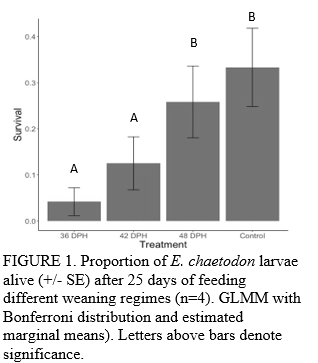CHARACTERIZING THE DIGESTIVE ENZYME ONTOGENY AND GASTROINTESTINAL MORPHOLOGY TO INFORM LARVAL FEEDING PROTOCOLS FORBLACKBANDED SUNFISH Enneacanthus chaetodon
Blackbanded Sunfish (Enneacanthus chaetodon ) are small ornamental centrarchids endemic to lakes and slow-moving water bodies from New Jersey to Central Florida. Their distribution has been increasingly fragmented due to habitat degradation, competition with non-native species, and in some cases, collection for the aquarium trade. Developing larval culture protocols is essential for the production of this species for the aquarium trade and for potential reintroduction to areas of extirpation . To gain insight into appropriate larval feeding and weaning protocols, the ontogeny of digestive enzyme activity and digestive tract morphology was assessed. E. chaetodon larvae were sampled 11 times from one-day post-hatch (dph ) to 50 dph and analyzed for trypsin, lipase, and acid protease activity via spectrophotometric microplate assays. Histochemistry was used to visualize neutral and acidic mucopolysaccharides and gastric glands. The presence of gastric glands and acid protease activity indicated that E. chaetodon transition ed from agastric to gastric digestion at 40 dph . These data were used to design a trial to identify the appropriate timing for weaning larvae from live feeds to an inert microparticulate diet (MD). E. chaetodon larvae were assigned one of four feeding regimes: Artemia nauplii (control) or transition to MD at 36, 42, or 48 dph with a five-day cofeeding period (n=4). After feeding for 25 days, s urvival was greatest in the control group or when MD was introduced at 48 dph , and no differences in length were found (Figure 1). These data were used to design a dietetics trial to test the efficacy of commercially available MDs. 48 dph larvae were assigned one of four diets: Artemia nauplii (control), or one of three MDs (n=4) . Certain MDs yielded higher survival than others and no differences in total length were found. Overall, larval E. chaetodon begin to transition to an adult mode of digestion around 40 dph and can be successfully transitioned to a MD after 48 dph without significantly affecting survival or growthtotal length.
